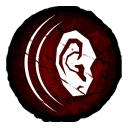Welcome to our beginner’s guide to the debuffs in Dead by Daylight. In this article, we will be discussing the negative status effects that are applied to both Survivors and Killers in the game. By understanding these debuffs, you can strategize and overcome them to become a stronger player. So, let’s dive into the basics of debuffs in Dead by Daylight.
Intro
Do not be intimidated by the guide’s sections!
While there are many sections, each one covers a single debuff (or multiple in really short length).
Try to only browse one or two debuffs at a time, focusing on ones you don’t know anything about.
Blindness
 Blindness is one of the most prolific negative statuses that Survivors can receive. It is also possible for Survivors to afflict Killers with Blindness. Many perks offer a side effect of Blindness, and almost every Killer has an add-on that temporarily Blinds survivors.
Blindness is one of the most prolific negative statuses that Survivors can receive. It is also possible for Survivors to afflict Killers with Blindness. Many perks offer a side effect of Blindness, and almost every Killer has an add-on that temporarily Blinds survivors.
When someone has the Blindness status effect, the vast majority of their Aura Reading is disabled. Killers and Survivors both have auras that can be read inherently without add-ons or perks, though some of them cannot be disabled through Blindness.
Not to be confused with Flashlight blindness.
Examples of default Survivor aura reading:
- Dying Survivors
- Hooked Survivors
- (When Dying) Other Survivors
- (When hooked) Other Survivors
Examples of default Survivor auras that CANNOT be disabled:
- The Pig’s Jigsaw Boxes
- The Mastermind and The Nemesis’ Vaccine Boxes
- The Singularity’s 3D Printers
(Essentially all similar map props that reveal their auras.)
Similarly, aura reading abilities like the Map, the perk Windows of Opportunity, or the perk Alert will all be functionally useless as long as the Survivor is Blind.
Examples of default Killer aura reading:
- Generators
- Hooks
Examples of default Killer auras that CANNOT be disabled:
- Powered Exit Gates
- The Lament Configuration (with the chatterer’s tooth)
- Dream Pallets/Traps
- Lockers (when Huntress is low on ammo)
(Again, map related props relevant to the killer or ability tend to be totally immune.)
Blindness is unfortunately a status effect that has middling impact in many games. While perks like Windows of Opportunity are common, Survivors communicating through Discord or other chats are immune to the downsides of not seeing Hooked or Dying survivors.
Not only that, but besides Hex: The Third Seal, almost all Blindness is a timed status. Perks like Ultimate Weapon can frequently apply it for long periods of time, but it’s not very useful to build into as a basis. If you were able to tell that Survivors were not grouped together, it may be better in the future.
Exhausted
 Exhausted is probably one of, if not the most common ailment in the game. The reason for this is that Survivors will often apply it to themselves.
Exhausted is probably one of, if not the most common ailment in the game. The reason for this is that Survivors will often apply it to themselves.
Exhaustion by itself does not do anything. However, perks like Adrenaline, Sprint Burst, etc. cannot be activated while you are exhausted. This makes the Killer’s ability to exhaust survivors even more deadly.
Survivors recover from Exhaustion naturally. As long as they are not sprinting, the status effect goes away 1 second at a time. At level 3, most Survivor perks will exhaust for 40 seconds. Crouching does NOT reduce the time it takes to recover. If a Survivor is Hooked, they are no longer Exhausted.
Survivor perks that induce Exhaustion:
- Sprint Burst
- Adrenaline
- Balanced Landing
- Lithe
- Background Player
- Overcome
- Dead Hard
- Dramaturgy
- Head On
- Smash Hit (only 20 seconds)
Additionally, Adrenaline will ignore Exhaustion. If you are permanently Exhausted, you will still get Adrenaline’s benefit. The perk Blood Rush can also skip your Exhaustion recovery, but does nothing if your Exhaustion timer is infinite.
Killers have a variety of their own methods, such as Blood Echo, Mindbreaker, and add-ons that cause Exhaustion. Notably, The Pig has an add-on that causes Exhaustion with no timer as long as you have a Reverse Bear-Trap on.
Because running an “Exhaustion Perk” is so powerful and often outright necessary, being Exhausted is a big deal. Exhaustion Perks like Sprint Burst allow incredible bursts of speed to escape the Killer or delay being hit, so ensuring you take the time to get rid of it is important.
Unfortunately for Killers, most sources of Exhaustion usually don’t have a noticeable impact, since they won’t trigger in the middle of chases a lot of the time.
Broken
 Broken is not all that uncommon to see as an effect applied by Survivors to themselves. However, some Killers are able to do so as well. Broken is notable as other Survivors will see the status next to a player’s icon.
Broken is not all that uncommon to see as an effect applied by Survivors to themselves. However, some Killers are able to do so as well. Broken is notable as other Survivors will see the status next to a player’s icon.
Broken Survivors cannot be healed past Injured. A Dying Survivor can be healed to Injured, but not further.
This also means that any effects that would heal the Survivor, such as Adrenaline, cannot make them full health. It still works for Dying/Deep Wound.
Survivors can apply Broken to themselves by:
- No Mither (Permanent)
- Deliverance
- Second Wind
- For the People
- Blood Rush
Some healing effects will be put on hold if you are Broken, however, most will not and will attempt to heal you fruitlessly.
Killers can also apply Broken in sparing amounts, such as Forced Penance, or The Plague’s sickness which maxes out by applying Broken.
Broken’s downsides are very clear, and while Endurance effects exist, they are less reliable than simply healing. Many Survivors are not in immediate danger from Broken’s effects, since they tend to hide until they pass – this also speaks to how Forced Penance tends to fizzle out a lot.
Broken is most deadly when it can be applied often, or for long periods of time, such as The Plague. The Plague’s ability to constantly make Survivors unable to heal, while punishing them for removing the status, makes her an incredibly effective user of the status effect.
Exposed
 Exposed is perhaps one of the deadliest debuffs that Survivors can receive. A hefty amount of Killers have Iridescent rarity Add-Ons that inflict Exposed for varying amounts of time.
Exposed is perhaps one of the deadliest debuffs that Survivors can receive. A hefty amount of Killers have Iridescent rarity Add-Ons that inflict Exposed for varying amounts of time.
In addition, there are many perks that will Expose one or multiple Survivors. The Shape and The Ghost Face have powers entirely built around the status debuff.
When a Survivor is Exposed, their screen will blur for a moment while a unique sound effect plays. This is to give extra warning.
Exposed Survivors can be put into the Dying State in a single Basic Attack.
This can be prevented with the Endurance positive buff, which will ensure the Survivor is put into Deep Wound instead. Survivors are also capable of giving themselves Exposed if they are using the perk Dramaturgy.
Here are some of the most likely ways to be Exposed:
- Hex: No One Escapes Death (Called NOED)
- Starstruck
- Iron Maiden
- Playing against The Ghost Face or The Shape.
Exposed is likely the worst debuff possible to receive, although sometimes it’s redundant if you are already injured.
It’s worth noting that the perks Dead Hard and Overcome become effectively worthless, as they cannot be activated without taking damage first, unless the Survivor already has Endurance.
Cursed
 Cursed is a semi-common debuff that occurs when the Killer is using a Hex perk. These perks often give very strong effects in exchange for being tied to Totems. Survivors can destroy (Cleanse) or Bless these Totems, removing the effect.
Cursed is a semi-common debuff that occurs when the Killer is using a Hex perk. These perks often give very strong effects in exchange for being tied to Totems. Survivors can destroy (Cleanse) or Bless these Totems, removing the effect.
Being cursed inherently does nothing, but signals the Killer has a Hex that has triggered. Hexes tend to only reveal themselves if they actually afflict you negatively. This can cause them to fly under the radar for a time.
Additionally, if you have the Cursed status effect, the Survivor perk Soul Guard will allow you to fully recover from the Dying State as long as you remain Cursed.
Below is a table that explains why a Hex reveals itself:
NOTE: Haunted Grounds, Two Can Play, Retribution, Thrill of the Hunt, and Undying were excluded as I am not aware of their full functionality. I do not believe Undying reveals itself to Survivors. The other Hexes reveal themselves, but I don’t recall if you remain Cursed.
As previously mentioned, Cursed doesn’t necessarily mean much on its own. A Hex can Expose you, but Cursed is more so there to remind you why you are Exposed.
You must be Cursed to recover from the Dying State without help while using Soul Guard, which is a positive at least.
Haemorrhage
 Haemorrhage is a debuff almost always paired with Mangled, which is covered in the section after this one. Many killers possess a way to apply Haemorrhage to Survivors through Add-Ons.
Haemorrhage is a debuff almost always paired with Mangled, which is covered in the section after this one. Many killers possess a way to apply Haemorrhage to Survivors through Add-Ons.
However, many killers may also choose to use Sloppy Butcher which applies Mangled and Haemorrhage together, and is relatively powerful for how simple and straightforward it is.
Survivors suffering from Haemorrhage leave pools of blood more often while injured, which can sometimes appear as leaving bigger pools of blood in general.
In addition, Survivors that are not fully healed will lose -7% of their healing progress per second when not being healed.
The loss of healing progress is particularly devastating, as it can make healing with a medkit useless if it lacks charges. If the Killer applies pressure to any healing survivors, they will almost certainly lose all of their healing progress before they can start healing again due to the fast drain.
Since Haemorrhage is almost always paired with Mangled, which slows healing, this can put Survivors on the back foot quickly and force them into hiding farther out.
Mangled
 Mangled is a fairly common negative status. As previously mentioned, it is very common for it to be paired with Haemorrhage to make a very useful combination.
Mangled is a fairly common negative status. As previously mentioned, it is very common for it to be paired with Haemorrhage to make a very useful combination.
Mangled causes Survivors to heal 20% slower. The debuff is only removed after they become Full Health, meaning that healing them from Dying to Injured will leave the debuff.
Many killers can give Survivors the Mangled status through Add-Ons, or they can use the perk Sloppy Butcher, which will make Basic Attacks always inflict Mangled and Haemorrhage together.
The following table lists some examples of healing speeds when slowed by Mangled. It does not account for each and every scenario
On its own this can be a fairly annoying, reliable way to slow-down Survivor gameplay or force them to work together to counteract the healing time penalties. Even if a Survivor is not interrupted, healing for roughly 26 seconds can be a major waste of time.
Where Mangled shines, though, is the fact that it’s often paired with Haemorrhage. If the heal is interrupted, it will almost always need to be completely restarted. If a Survivor begins healing someone with no medkit, a 20 second heal is already a long time.
But if they stop healing to hide from the Killer, say for 15 seconds, then begin healing again they will need to completely redo any progress on their 20 second heal. This wastes tons of time and can often allow you to keep Survivors injured for longer.
Hindered
 Hindered is a status effect that can be applied to Killers and Survivors. Unlike Mangled, there is no universal Hindered penalty. To be Hindered is to have your movement speed reduced. How Hindered you are is dependent on the source.
Hindered is a status effect that can be applied to Killers and Survivors. Unlike Mangled, there is no universal Hindered penalty. To be Hindered is to have your movement speed reduced. How Hindered you are is dependent on the source.
Because of this inconsistency, it takes a lot more knowledge of the game to know how much danger you are in. Regardless, all Hindered is dangerous to both sides, due to the fragile speed difference in Killers and Survivors.
Below is a table of very strong or notable sources of Hindered used by Killers:
Below is a table of very strong or notable sources of Hindered used by Survivors:
Hindered is an extremely important status effect to keep track of, and I encourage you to look into the rest of the numbers for Hindered yourself. Because Survivors inherently move slower than Killers, the time it takes to get hit by a Basic Attack or Special Attack only gets shorter.
Not only that, but the Hindered penalty applies to any speed boost you get. Lithe is not as useful if it is ~19% slower.
Killers suffer similarly. They are by default only 10-15% faster than Survivors, which means that if they are slowed down even marginally it can be a huge loss of time. Chemical Trap does not last very long, but if placed on a pallet that must be broken to proceed, it can make an enormous difference.
Oblivious
 Oblivious is a Survivor-only debuff, but it comes as a double-edged sword for Killers who aren’t paying close attention.
Oblivious is a Survivor-only debuff, but it comes as a double-edged sword for Killers who aren’t paying close attention.
Oblivious is commonly applied through perks (Hysteria, Plaything, etc.), but some Killers have Add-Ons that will do it as well. A few Killer powers are capable of applying Oblivious with no extra requirements.
Survivors who are Oblivious do not hear Terror Radius music, and do not hear the Heartbeat when the Killer is very close to them. They will still hear the Huntress’ Lullaby, and the Nightmare’s Lullaby. This allows Killers to easily sneak up on them.
However, because Survivors cannot hear the Terror Radius, any effect that triggers inside of it will no longer trigger. For instance, Unnerving Presence makes skillchecks smaller within the Terror Radius. If a Survivor does not perceive themselves to be in it, they have normal skillchecks.
Survivors can also still see the aura of the Killer.
Oblivious is very clearly dangerous, as it disables the ability to hear the Killer. Killers that are able to physically hide, or generators that are stuck in broom closets, will leave you reliant on sound. Without this, it makes it simple for them to sneak up on you.
With that in mind, many Survivors are able to communicate through Discord or other chats, read the Killer’s aura, or see them coming, and consider Oblivious not a problem. Part of this is due to the Hex: Plaything and Hex: Pentimento combo that is considered very strong and very common.
Deep Wound
 Deep Wound is a commonly found status. A handful of Killers and their Add-Ons inflict Deep Wound, such as The Legion’s Feral Frenzy.
Deep Wound is a commonly found status. A handful of Killers and their Add-Ons inflict Deep Wound, such as The Legion’s Feral Frenzy.
However, it’s actually more common for Survivors to give themselves Deep Wound. Survivors can obtain the Endurance buff, which prevents them from being put into the Dying State as long as they have it. Instead, they enter Deep Wound.
Perks like Dead Hard or Buckle Up give Endurance, while all Survivors receive it when unhooked.
During Deep Wound, a Survivor:
- Has a yellow bar beneath their name (Bleedout timer)
- Slowly loses coloration of their screen as they bleedout
- Slowly gets more blood splashes on their screen as they bleedout
- Will enter the Dying State if they Bleedout
Survivors won’t bleedout while sprinting or while mending. Mending is the unique action a Survivor must perform, or have someone else perform on them, to cure Deep Wound. It is possible to refresh Deep Wound by getting another Endurance state.
It takes 12 seconds to Mend, 8 seconds to be mended by another survivor, and 5.3 seconds to be mended by two Survivors.
NOTE: Deep Wound is considered a health state. This means anything that cures the Survivor of one health state, such as Adrenaline, will move them from Deep Wound to Injured instead of Healthy.
Deep Wound’s bleedout timer is not very serious, as it lasts a long time and is paused while sprinting. It’s possible to wiggle in place while holding sprint to stop it from going down too far.
Deep Wound still comes with two big downsides: Adding 5-12 seconds onto healing, as you must be Mended before going from Injured to Healthy. Some killers can actually make Mending take longer, making the situation even worse.
The other downside is that because it counts as a health state, anything that automatically heals you for one health state, such as Adrenaline, will not make you Healthy. Only Injured.
Incapacitated

Incapacitated is a relatively rare status effect. It can only be applied to Survivors, although one of the methods is something they do themselves.
Incapacitated can only be applied by:
- The Twins, by getting pounced by Victor
- The Cenobite, by getting hit with a Chain
- The Huntress, by getting hit with her Hatchet while she uses Weighted Head add-on
- Picking up a Flame Turret while in a Trial against The Xenomorph.
Incapacitated prevents Survivors from doing the following actions:
- Cannot break or bless totems
- Cannot use held items, such as med-kits
- Cannot heal or mend yourself or others
- Cannot repair
- Cannot sabotage
No other actions are prevented by Incapacitated, though they tend to have other penalties. The Cenobite’s chain, for instance, prevents leaving through the Exit Gate. The Flame Turret causes Exhaustion, which is covered in the next section.
In theory, the actions limited by being Incapacitated would make for a devastating status effect. However, in every circumstance where Survivors can be Incapacitated, it usually does not last very long or they have other things to worry about. Cenobite slows Survivors with his chains, and being pounced by Victor means Charlotte is on her way.
Overall, if you find yourself Incapacitated and you’re not playing against Huntress, you are probably about to be in much bigger trouble unrelated to the actual status effect. The 10s of the add-on are menial at best.
Deafened
 Deafened is one of the less impactful debuffs in the game. Survivors or Killers suffering from the debuff have muffled audio, sometimes hearing a whistling sound as if they had tinnitus.
Deafened is one of the less impactful debuffs in the game. Survivors or Killers suffering from the debuff have muffled audio, sometimes hearing a whistling sound as if they had tinnitus.
As of now, only two Killer activated sources exist (Knock Out the Hag add-on Disfigured Ear). Survivors, however, can Deafen themselves with their sources of activation as well.
The primary way to become Deafened are through the Firecracker items, which are typically put in the bloodweb during seasonal events like Chinese New Years or Christmas. These items are one time use, and are dropped on the ground when used.
After a few moments, they explode in a radius, blinding and deafening any Survivor or Killer too close to the explosion. They are known for being generously easy to use in rescuing Survivors or forcing Killers to go blind and deaf during a Pallet Break.
The perk Flashbang allows Survivors to craft very similar items.
The lack of ability to hear impacts Killers more often than Survivors. The deafening effect from Knock Out is fairly useless, as it only affects Survivors who enter the Dying State, while the Disfigured Ear is relatively niche.
Killers rely on hearing Survivors grunt in pain or sprint across surfaces whenever they go blind, so making it harder for them to hear can make it harder to track Survivors and potentially make them unable to find them.
Extra: Sleep, Madness, Glyphs
 When playing against The Nightmare (Freddy Krueger), Survivors will begin to fall asleep over time.This comes with its own variety of debuffs. Survivors who aren’t asleep can wake others up.
When playing against The Nightmare (Freddy Krueger), Survivors will begin to fall asleep over time.This comes with its own variety of debuffs. Survivors who aren’t asleep can wake others up.
Every time you are woken up by another Survivor instead of using an Alarm Clock, the Sleep debuff gets worse, and it takes progressively longer to wake up from other Survivors.
 Madness can only be obtained by playing against The Doctor. Madness goes from Tier 1 to Tier 3. Once you have Madness 1, you cannot remove it. In Madness 3, you will be inhibited from performing most actions including Mending, while periodically screaming. You can perform an action to remove Madness 3 and return to Madness 1.
Madness can only be obtained by playing against The Doctor. Madness goes from Tier 1 to Tier 3. Once you have Madness 1, you cannot remove it. In Madness 3, you will be inhibited from performing most actions including Mending, while periodically screaming. You can perform an action to remove Madness 3 and return to Madness 1.
The effects of Madness depend on what Add-Ons the Killer is using.
 Certain Tome Archive challenges will give players Glyph challenges. Some, like Red Glyphs, only have to be collected. Other challenges will give more complex Glyphs.
Certain Tome Archive challenges will give players Glyph challenges. Some, like Red Glyphs, only have to be collected. Other challenges will give more complex Glyphs.
One of the type of Glyph challenges involves a Glyph that gives you a debuff. This icon denotes that you have collected a debuff Glyph.
Extra: Progress/Perks/Add-On Icons

Progress bars turn red when a Survivor or Killer is performing an action slower than usual.
This can be intentional – some Killer add-ons slow down how fast a Power charges. If multiple Survivors work on a generator together, their individual repair speed is lowered, making the bar appear red despite being faster.
Icons often appear above the progress bar, such as two triangles (“fast-forward” icon). The color of the icon indicates if it is going faster (yellow) or slower (red). This occurs with Skillcheck Size, as well as Skillcheck Frequency.
 Sometimes a negative debuff is incredibly specific, or for balance reasons must be displayed so that you know why something is happening.
Sometimes a negative debuff is incredibly specific, or for balance reasons must be displayed so that you know why something is happening.
In this case, Killer Add-Ons, powers, or perks will be displayed. In this example, Dying Light is shown, so that you know you are repairing slower due to a Killer perk.
Unfortunately, this also means that you must be aware what Dying Light’s icon is, and what its effect does.
Extra: Vigil (Survivor Perk)
 Vigil is a Survivor perk originating from Quentin Smith. The purpose of the perk is to aid against many debuffs.
Vigil is a Survivor perk originating from Quentin Smith. The purpose of the perk is to aid against many debuffs.
Increases your recovery rate from Blindness, Broken, Exhaustion, Exposed, Haemorrhage, Hindered, and Oblivious status effects by 20/25/30%.
This effect also applies to all other Survivors within 8 meters of your location and lingers for 15 seconds.
There are a lot of things to go over with Vigil to properly understand how it works, as many players get confused in the process.
1. MOST IMPORTANT: Vigil works DIFFERENTLY than you think!
- Vigil does not remove 30% of the timer for a status effect. Instead of recovering 1 charge per second, you recover 1.3 charges per second. With only one Vigil, 40 seconds of Exhaustion recover in 30 seconds instead of 28.
2. Vigil DOES stack
- If multiple Survivors use Vigil, they stack together, meaning you recover 60/90/120% faster.
3. Vigil does not work against everything.
- Your status effect must have a timer. Sloppy Butcher applies infinite Haemorrhage and Mangled. Ghost Face, Shape, and Devour Hope apply infinite Exposed by the game’s logic. These will not recover faster.
4. Vigil lingers for 15 seconds.
- This means if you leave 8 meters of the person using it, your cooldowns are still faster for 15 seconds.
Outro
If you have any notes, corrections, suggestions, etc. leave them in the comments.
If you would like to adapt the guide somewhere else (YouTube, Forums, Reddit, etc.) please leave a comment first and let me get back to you.
And that wraps up our share on Dead by Daylight: Beginner’s Debuff Guide. If you have any additional insights or tips to contribute, don’t hesitate to drop a comment below. For a more in-depth read, you can refer to the original article here by Valentine, who deserves all the credit. Happy gaming!
